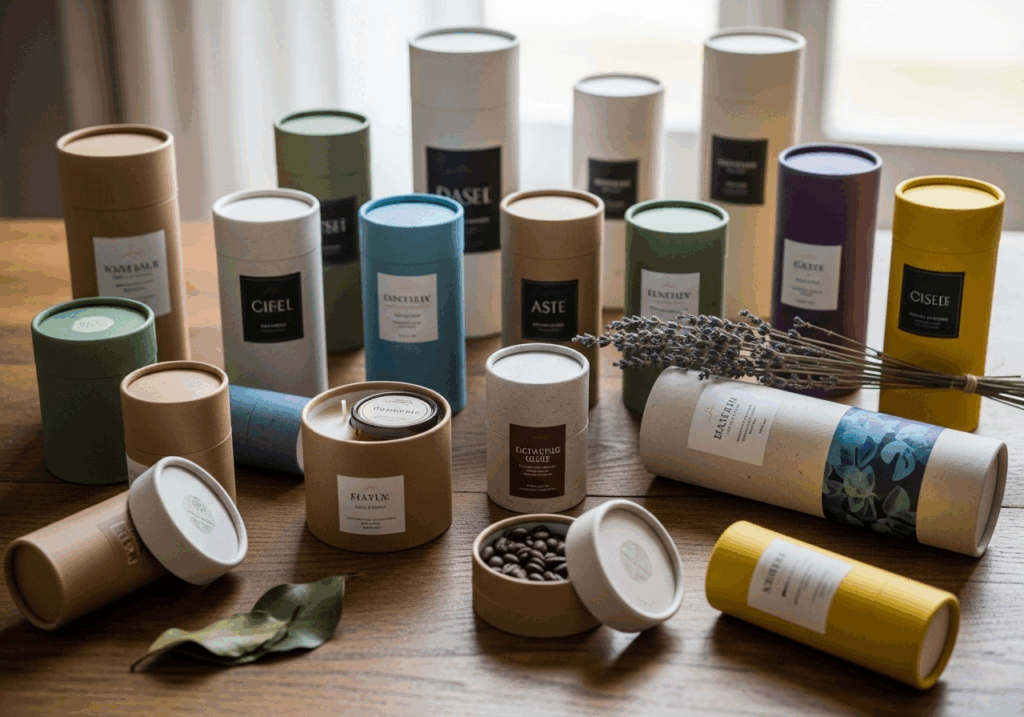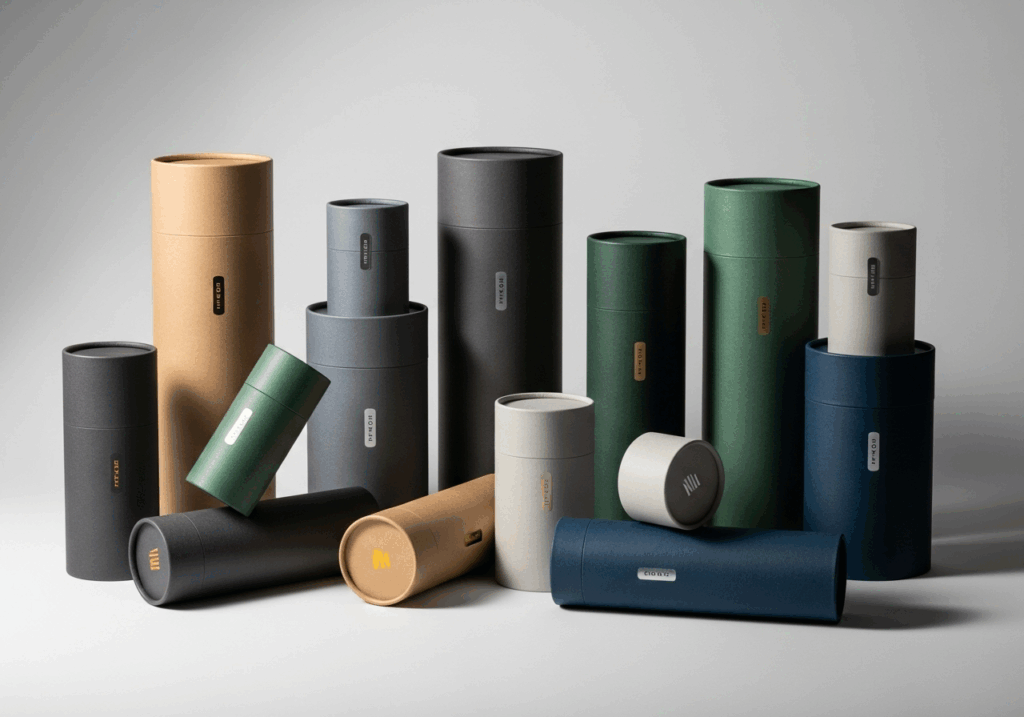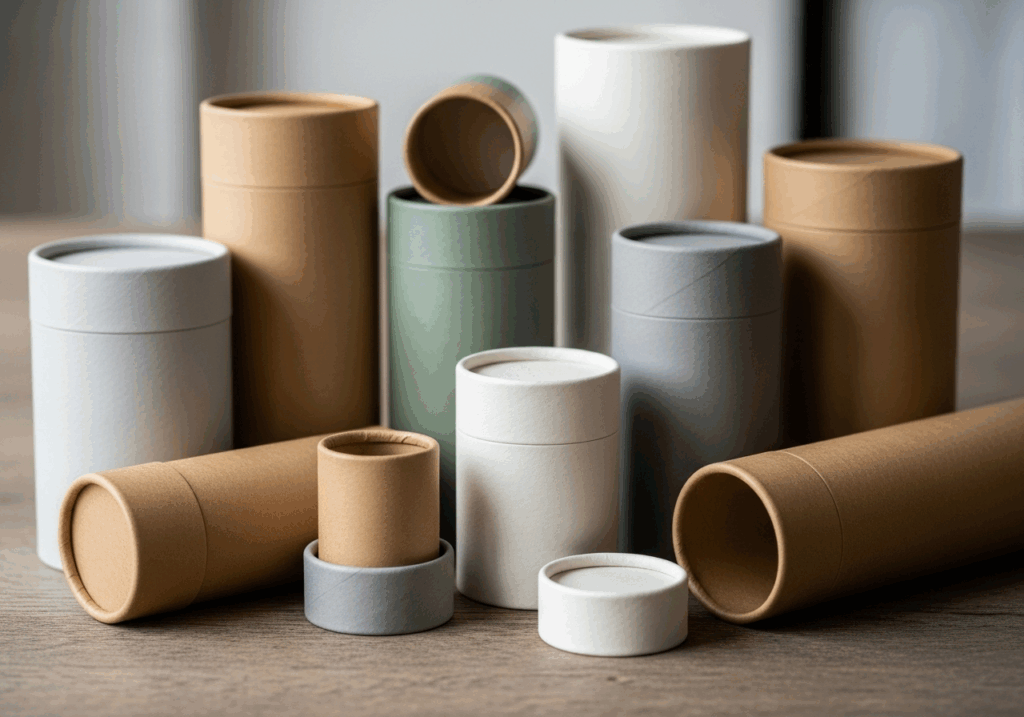Advantages of Cylinder Packaging
Discover the benefits of cylinder packaging. This guide explores its unique visual appeal, functional advantages, and sustainable options to enhance your brand.
Summary
Cylinder packaging refers to containers with a cylindrical shape, which offers distinct benefits over traditional packaging formats such as rectangular boxes and flexible pouches. Notable for its visual appeal, cylindrical packaging captures consumer attention more effectively on retail shelves, enhancing brand visibility and differentiating products in a competitive market. Research indicates that packaging design significantly influences purchasing decisions, with studies showing that up to 72% of consumers consider packaging design when making choices. The sleek and modern aesthetics associated with cylindrical packaging often evoke perceptions of luxury and quality, making it a favored option among brands seeking to elevate their product presentation.
In addition to its visual advantages, cylindrical packaging provides functional benefits, including efficient space utilization and enhanced product protection. The rounded structure allows for better stacking and storage, optimizing logistics for e-commerce and shipping. Moreover, cylindrical containers distribute stress evenly, reducing the likelihood of damage during transportation, thus ensuring product integrity upon delivery. This combination of practicality and aesthetics makes cylindrical packaging a versatile choice across various industries, including cosmetics, food, and apparel, allowing brands to tailor solutions to meet specific consumer needs.
Sustainability is another critical advantage of cylindrical packaging, as many options are made from recyclable and biodegradable materials, addressing the growing consumer demand for environmentally friendly solutions. Traditional packaging, often reliant on non-recyclable plastics, faces increasing scrutiny due to its ecological impact. By adopting sustainable practices in cylindrical packaging, brands not only enhance their image but also align with consumer preferences for eco-conscious alternatives. This commitment to sustainability is further reflected in industry trends towards materials that minimize negative environmental effects, reinforcing the relevance of cylindrical packaging in the context of global environmental challenges.
While the advantages of cylinder packaging are compelling, the topic is not without its controversies, particularly regarding the broader implications of packaging waste and recycling challenges. Despite advancements in recycling technologies, a significant portion of packaging still ends up in landfills, raising concerns about environmental sustainability. Nonetheless, the potential for innovation in design and materials within cylindrical packaging presents opportunities for brands to foster consumer loyalty and respond to ecological demands, making it a notable topic within the packaging industry.
Table of Contents
Comparison with Other Packaging Types
Cylindrical packaging presents several distinct advantages when compared to traditional packaging types, such as rectangular boxes or flexible pouches. This section explores the unique characteristics and benefits of cylindrical packaging in relation to its counterparts.
Visual Appeal and Brand Differentiation
Cylindrical packaging is inherently designed to stand out on retail shelves. Its unique shape and form factor often draw consumer attention, enhancing brand visibility compared to standard rectangular packaging. Research shows that packaging design significantly influences purchasing decisions; a poll conducted by Ipsos found that 72% of consumers believe packaging design affects their choices. The sleek, modern look of cylindrical packaging can create a perception of luxury and high-end quality, setting products apart in a crowded market.
Functional Benefits
In terms of functionality, cylindrical packaging offers advantages such as efficient use of space. Its shape allows for better stacking and storage options, which can be particularly beneficial in e-commerce and shipping scenarios. Furthermore, cylindrical containers often provide superior protection for the product within, as the rounded structure distributes stress evenly, reducing the likelihood of damage during transportation.
Sustainability Considerations
Cylindrical packaging can also contribute to sustainability goals. Many cylindrical packaging options are made from recyclable and biodegradable materials, aligning with the growing consumer demand for eco-friendly solutions. By utilizing sustainable materials, brands can enhance their image and appeal to environmentally conscious consumers. In contrast, traditional packaging materials, such as non-recyclable plastics, are increasingly scrutinized for their environmental impact.
Versatility Across Industries
Cylindrical packaging is versatile and finds applications across various industries, including cosmetics, food, and apparel. Its adaptability to different product types makes it a favored choice for brands looking to create unique packaging solutions that cater to specific consumer needs. For instance, it can be effectively used for packaging cosmetics, candles, or clothing items, providing an elegant and professional presentation.
Customization Potential
The ability to customize cylindrical packaging is another notable advantage. Brands can easily adjust the dimensions, materials, and designs to align with their branding and functional requirements, allowing for tailored solutions that resonate with their target audience. This customization capability can be more limited in traditional packaging formats, which often come in fixed sizes and shapes.

Environmental Considerations
The environmental implications of packaging materials are critical in evaluating their overall sustainability and impact on the ecosystem. Packaging materials contribute significantly to carbon emissions, deforestation, and habitat destruction, making the choice of materials crucial for minimizing these negative effects. Sustainable packaging materials, such as plant-based bioplastics, recycled materials, bamboo, and jute, are increasingly favored as they tend to have a lower carbon footprint compared to traditional options. The lifecycle of these materials, from production to disposal, embodies the principles of sustainability by integrating economic, social, and environmental considerations across all stages of the supply chain.
Lifecycle Assessment of Packaging Materials
A comprehensive assessment of packaging materials considers both direct and indirect environmental effects. Direct effects arise from the production, use, and disposal of packaging, while indirect effects encompass broader environmental concerns. For instance, materials engineered for extended shelf life may preserve food effectively but often result in long-lasting environmental pollution due to their resistance to degradation, contributing to litter and ecosystem harm. Sustainable packaging, on the other hand, aims to optimize the use of materials and energy, promoting efficient recovery and reuse in multiple production cycles.
Impact on Biodiversity
Choosing materials that minimize negative impacts on biodiversity is essential for preserving fragile ecosystems and maintaining ecological balance. Unsustainable packaging, particularly those derived from resource-intensive processes, can lead to habitat loss and the disruption of ecosystems, further exacerbating environmental degradation. Embracing sustainable materials, including recycled and biodegradable options, reflects a growing consumer demand for eco-friendly alternatives and enhances brand image by attracting environmentally conscious customers.
Waste Management and Recycling Challenges
Despite advancements in recycling, a significant portion of packaging waste remains non-recyclable or single-use, contributing to landfill overflow and pollution. The recycling rate in the U.S. has improved, but the high cost of recycling relative to landfilling discourages businesses and municipalities from engaging in effective recycling practices. Reducing packaging waste is essential for protecting the environment, and companies are encouraged to implement strategies such as designing smaller, more efficient packages, utilizing reusable containers, and participating in take-back programs. By fostering a culture of sustainability, brands can empower consumers to make eco-friendly choices while minimizing their environmental footprint.

Case Studies
Successful Implementations
One notable case is the introduction of small juice containers, which have gained popularity among consumers seeking convenient, single-serving options. By utilizing innovative cylinder packaging, these companies not only provide high-quality, easily accessible products but also actively contribute to reducing plastic waste. This aligns with the growing demand for sustainable packaging solutions, highlighting the industry’s responsiveness to consumer preferences and environmental considerations.
Another example is Wulftec International, a provider of customizable packaging solutions that has empowered clients facing unique packaging challenges. Their equipment, designed for durability and ease of use, exemplifies how cylinder packaging can offer peace of mind to businesses regarding the safe and effective containment of goods. Wulftec’s commitment to exceptional quality and service demonstrates the importance of collaboration in overcoming packaging obstacles.
Industry Utilization of Cylinder Packaging
Various industries have successfully implemented cylinder packaging solutions to enhance their product offerings and align with sustainability goals. For instance, companies have reported increased consumer preference for ergonomic packages, which facilitate easy handling, opening, and pouring, illustrating the advantages of cylindrical containers in practical applications. The adaptability of these containers allows them to cater to a diverse range of products, making them a versatile choice across multiple sectors.
Innovations in Food Packaging
Recent developments in food packaging have also focused on biobased and biodegradable polymers for cylindrical containers. Research indicates that such advancements not only enhance product shelf life but also cater to consumer preferences for eco-friendly materials. By adopting these innovative materials, companies can bridge the gap between technological advancements and social responsibility, ultimately leading to sustainable practices that resonate with consumers.

Consumer Perception
Consumer perception plays a pivotal role in shaping the effectiveness of cylinder packaging within the broader context of brand marketing and consumer behavior. Packaging is not merely a protective layer; it serves as a critical communication tool that conveys brand values and influences purchasing decisions. Effective cylinder packaging can significantly differentiate products from competitors, fostering brand loyalty and driving sales.
The Influence of Packaging Design
The packaging design, particularly in cylindrical forms, is crucial for capturing consumer attention. Research indicates that visual appeal is a substantial factor in consumer decision-making, with studies showing that 70% of consumers make their purchase decisions based solely on packaging. The unique shape of cylinder packaging can evoke specific emotions and associations, reinforcing brand identity and enhancing consumer engagement. For instance, the rounded shape is often perceived as friendly and approachable, which can positively affect consumer perception and buying behavior.
Emotional Connection and Brand Loyalty
Cylinder packaging also creates opportunities for brands to establish emotional connections with consumers. This connection is critical as emotional stimuli often determine purchasing decisions. Packaging that resonates with consumers’ beliefs or values can lead to increased loyalty; studies suggest that 71% of consumers are more inclined to purchase from brands that align with their personal values. By leveraging storytelling and consistent branding within their packaging design, companies can enhance their image and drive deeper customer loyalty.
The Unboxing Experience
The unboxing experience, particularly in the context of online retail, is another crucial factor in consumer perception. A well-designed cylindrical package can transform an ordinary delivery into a memorable experience, creating positive emotional responses that encourage repeat purchases. Elements such as innovative designs, personalized messages, or unexpected surprises can further enrich this experience, reinforcing brand loyalty and encouraging word-of-mouth promotion.
Psychological Factors in Consumer Choices
Understanding the psychological aspects of consumer perception is essential for designing effective cylinder packaging. The shape, color, and overall aesthetic can evoke specific emotions and influence purchasing decisions. For example, vibrant colors and unique shapes inherent in cylinder packaging can attract attention and differentiate a product in a saturated market, impacting consumer behavior positively. This psychological engagement plays a significant role in a consumer’s willingness to choose one brand over another.
